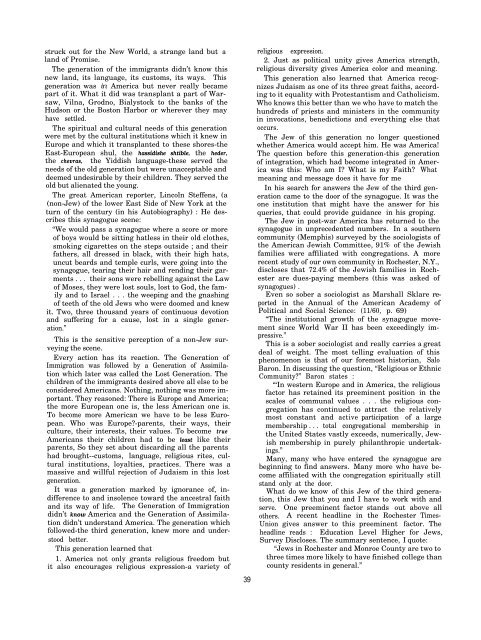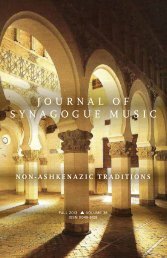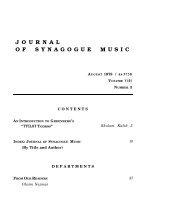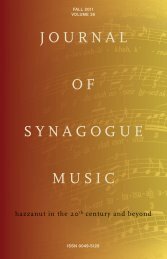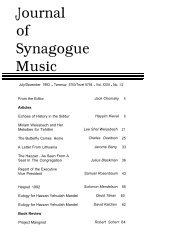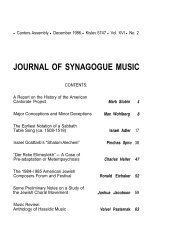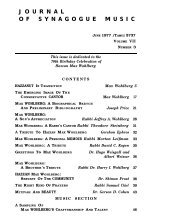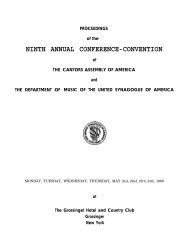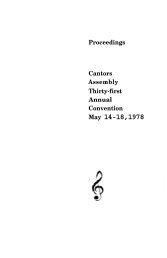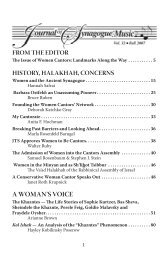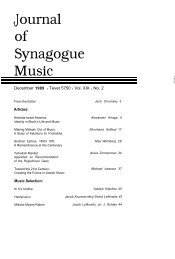1964 Proceedings - Cantors Assembly
1964 Proceedings - Cantors Assembly
1964 Proceedings - Cantors Assembly
You also want an ePaper? Increase the reach of your titles
YUMPU automatically turns print PDFs into web optimized ePapers that Google loves.
struck out for the New World, a strange land but a<br />
land of Promise.<br />
The generation of the immigrants didn’t know this<br />
new land, its language, its customs, its ways. This<br />
generation was in America but never really became<br />
part of it. What it did was transplant a part of Warsaw,<br />
Vilna, Grodno, Bialystock to the banks of the<br />
Hudson or the Boston Harbor or wherever they may<br />
have settled.<br />
The spiritual and cultural needs of this generation<br />
were met by the cultural institutions which it knew in<br />
Europe and which it transplanted to these shores-the<br />
East-European shul, the hassidishe shtible, the heder,<br />
the chevras, the Yiddish language-these served the<br />
needs of the old generation but were unacceptable and<br />
deemed undesirable by their children. They served the<br />
old but alienated the young.<br />
The great American reporter, Lincoln Steffens, (a<br />
(non-Jew) of the lower East Side of New York at the<br />
turn of the century (in his Autobiography) : He describes<br />
this synagogue scene:<br />
“We would pass a synagogue where a score or more<br />
of boys would be sitting hatless in their old clothes,<br />
smoking cigarettes on the steps outside ; and their<br />
fathers, all dressed in black, with their high hats,<br />
uncut beards and temple curls, were going into the<br />
synagogue, tearing their hair and rending their garments<br />
. . . their sons were rebelling against the Law<br />
of Moses, they were lost souls, lost to God, the family<br />
and to Israel . . . the weeping and the gnashing<br />
of teeth of the old Jews who were doomed and knew<br />
it. Two, three thousand years of continuous devotion<br />
and suffering for a cause, lost in a single generation.”<br />
This is the sensitive perception of a non-Jew surveying<br />
the scene.<br />
Every action has its reaction. The Generation of<br />
Immigration was followed by a Generation of Assimilation<br />
which later was called the Lost Generation. The<br />
children of the immigrants desired above all else to be<br />
considered Americans. Nothing, nothing was more important.<br />
They reasoned: There is Europe and America;<br />
the more European one is, the less American one is.<br />
To become more American we have to be less European.<br />
Who was Europe?-parents, their ways, their<br />
culture, their interests, their values. To become true<br />
Americans their children had to be least like their<br />
parents, So they set about discarding all the parents<br />
had brought--customs, language, religious rites, cultural<br />
institutions, loyalties, practices. There was a<br />
massive and willful rejection of Judaism in this lost<br />
generation.<br />
It was a generation marked by ignorance of, indifference<br />
to and insolence toward the ancestral faith<br />
and its way of life. The Generation of Immigration<br />
didn’t know America and the Generation of Assimilation<br />
didn’t understand America. The generation which<br />
followed-the third generation, knew more and understood<br />
better.<br />
This generation learned that :<br />
1. America not only grants religious freedom but<br />
it also encourages religious expression-a variety of<br />
39<br />
religious expression.<br />
2. Just as political unity gives America strength,<br />
religious diversity gives America color and meaning.<br />
This generation also learned that America recognizes<br />
Judaism as one of its three great faiths, according<br />
to it equality with Protestantism and Catholicism.<br />
Who knows this better than we who have to match the<br />
hundreds of priests and ministers in the community<br />
in invocations, benedictions and everything else that<br />
occurs.<br />
The Jew of this generation no longer questioned<br />
whether America would accept him. He was America!<br />
The question before this generation-this generation<br />
of integration, which had become integrated in America<br />
was this: Who am I? What is my Faith? What<br />
meaning and message does it have for me<br />
In his search for answers the Jew of the third generation<br />
came to the door of the synagogue. It was the<br />
one institution that might have the answer for his<br />
queries, that could provide guidance in his groping.<br />
The Jew in post-war America has returned to the<br />
synagogue in unprecedented numbers. In a southern<br />
community (Memphis) surveyed by the sociologists of<br />
the American Jewish Committee, 91% of the Jewish<br />
families were affiliated with congregations. A more<br />
recent study of our own community in Rochester, N.Y.,<br />
discloses that 72.4% of the Jewish families in Rochester<br />
are dues-paying members (this was asked of<br />
synagogues) .<br />
Even so sober a sociologist as Marshall Sklare reported<br />
in the Annual of the American Academy of<br />
Political and Social Science: (11/60, p. 69)<br />
“The institutional growth of the synagogue movement<br />
since World War II has been exceedingly impressive.”<br />
This is a sober sociologist and really carries a great<br />
deal of weight. The most telling evaluation of this<br />
phenomenon is that of our foremost historian, Salo<br />
Baron. In discussing the question, “Religious or Ethnic<br />
Community?” Baron states :<br />
“‘In western Europe and in America, the religious<br />
factor has retained its preeminent position in the<br />
scales of communal values . . . the religious congregation<br />
has continued to attract the relatively<br />
most constant and active participation of a large<br />
membership . . . total congregational membership in<br />
the United States vastly exceeds, numerically, Jewish<br />
membership in purely philanthropic undertakings.”<br />
Many, many who have entered the synagogue are<br />
beginning to find answers. Many more who have become<br />
affiliated with the congregation spiritually still<br />
stand only at the door.<br />
What do we know of this Jew of the third generation,<br />
this Jew that you and I have to work with and<br />
serve. One preeminent factor stands out above all<br />
others. A recent headline in the Rochester Times-<br />
Union gives answer to this preeminent factor. The<br />
headline reads : Education Level Higher for Jews,<br />
Survey Discloses. The summary sentence, I quote:<br />
“Jews in Rochester and Monroe County are two to<br />
three times more likely to have finished college than<br />
county residents in general.”


